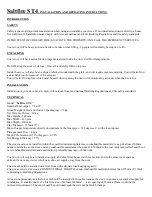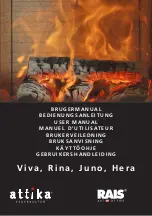
INSTALLATION
Page 13
INSTALLING YOUR PELLET STOVE
Standard Horizontal Exhaust Installation (Direct
Vent)
1. Locate the proper position for the listed type “PL”
wall thimble. Avoid cutting wall studs when installing
your pipe. Use a saber saw or keyhole saw to cut
the proper diameter hole through the wall to accom-
modate the wall thimble. Use extreme caution to
avoid cutting into power lines within the wall of the
home. The hole size will depend on the brand of
pellet vent that you are using. Install the wall thimble
in the hole.
ALL INTERLOCKING PIPE CONNECTIONS WITH-
IN THE ROOM MUST BE SEALED WITH RTV AND
SECURED WITH A MINIMUM OF 3 FASTENERS
PER CONNECTION.
2. Position the stove approximately 12” (.3M) from the
wall on the floor pad. Push listed type “PL” pipe
through wall thimble. Squeeze a bead of high tem-
perature silicone (RTV) sealer around the end of the
machined portion of the 3” (75mm) pipe connector
on the back of the stove. Firmly push on a section of
listed type “PL” pipe until inner pipe liner pushes into
the bead of RTV sealer
3. Push the stove (with pipe attached) towards wall.
Pipe will go through the wall thimble. Do not position
the back of the stove closer than 1” (25mm) from the
wall.
NOTE: Greater back clearance will improve the ser-
viceability of the stove.
4. Install listed type “PL” 45-degree elbow with rodent
screen or cap (optional) on outside end of pipe. The
rodent screen should be no less than 1/2” (13mm)
mesh and may clog with soot and ash if left unat-
tended during the burn season.
NOTE: The end of the exhaust pipe must extend a
minimum of 12” (.3M) from the outside of the building.
5. If the installation includes a source of outside com-
bustion air; cut a separate hole through the wall for
the fresh air tube. This tube should be 1-5/8” (42mm)
[min.] diameter, steel only. Connect outside air pipe
to air inlet on stove. This tube must be terminated
with a 90 degree elbow or hood.
NOTE: Combustion air may also be drawn from a
vented crawl space under the home. All joints for con-
nector pipe are required to be fastened with at least
three screws. If vented horizontally, joints shall be made
gas-tight in a manner as specified above. Install vent at
clearances specified by the vent manufacturer.
Summary of Contents for Traditions T300P Series
Page 28: ...WIRING DIAGRAM Page 28 ...
Page 33: ...REPLACEMENT PARTS DIAGRAMS Page 33 1 2 3 4 6 7 8 10 11 12 5 9 ...
Page 34: ...REPLACEMENT PARTS DIAGRAMS Page 34 14 15 16 17 20 21 22 24 25 23 27 13 18 ...
Page 36: ...INSTALLATION TIPS Page 36 ...














































